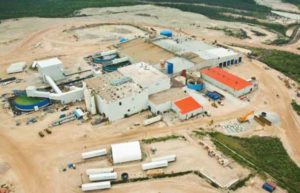Is Uranium Poised for a Renaissance?

Cameco Corp.'s underground Rabbit Lake uranium mine in the Athabasca Basin about 700 km north of Saskatoon, Saskatchewan. Photo courtesy Cameco Corp.
By Thomas Schuster

The short answer is yes. Numerous supply and demand statistics clearly point to that conclusion. The real question is not if the uranium price will rise but when?
“Uranium is trading around US $30/lb,” said Peter Dasler, President and CEO of CanAlaska Uranium [CVV-TSXV; CVVUF-OTCQB; DH7-FSE] in an interview. “There is a lot of extra supply in the market because of stockpiles created when Japanese reactors were taken off-line for safety concerns after Fukushima.”
“These stockpiles are being reprocessed and enriched so that they effectively do more work,” said Dasler. “This enriched uranium is being sold onto the market and also helping to depress the price.”
According to the World Nuclear Association, the effect of Japanese reactor shut-downs was dramatic. In 2010, just before the Japanese earthquake and Tsunami, demand for uranium for nuclear power plants was 167 million lbs. About 142 million lbs U3O8 came from mines and 23 million lbs were sourced from secondary supply. This left a 2 million-lb deficit. In 2014, demand from reactors was 175 million lbs, 148 million lbs were mined and 43 million lbs were sourced from secondary stockpiles. This left a 16 million lb surplus. This drop in demand has been devastating to the uranium market
However, fundamentals are changing and a supply-side deficit is being predicted by analysts. The Japanese government approved plans to source 20-22% of its electrical needs from nuclear power. Towards that end, Japan’s National Regulation Authority has received 24 reactor restart applications and five have been approved for restart.
Dasler believes the market is just now considering the impact the restart of Japanese reactors will have on the supply side. When you add that to the Chinese commissioning a new reactor every month Dasler feels that we will see speculators come into the market long before stockpiles are used up.
“Don’t forget, in order to start up a reactor you will need twice as much uranium in the first year as you will in ongoing use. Most reactors won’t even start up operations until they have stockpiled at least seven years of uranium,” he said. “I believe we will see a sudden increase in demand to secure a guaranteed uranium stockpile supply.”
When we look at some of the statistics compiled by various sources like the World Nuclear Association, IAEA country profiles and the European and American nuclear societies, the facts all point to significant increases in future demand. This increase in uranium demand cannot be met by current mine supply.
- There are 440 commercial nuclear power reactors operable in 31 countries with over 380,000 MWe of total capacity.
- These provide 11% of the worlds electricity as continuous, reliable base-load power without carbon dioxide emissions
- 56 countries operate a total of about 240 research reactors and a further 180 nuclear reactors power some 140 ships and submarines
- 65 reactors under construction
- 159 reactors on order or planned
- A total of 90 (net) new reactors expected by 2022
- Global electricity demand is expected to grow 76% by 2030 and half of this increase in energy growth will come from Asia
- Uranium demand is expected to grow by 45% by 2030. That translates to about 3.1% per year
- 10 new reactors put on line in 2015: China (8), South Korea (1) and Russia (1) (9,497 WMe of installed capacity)
- The US has 99 operating reactors, which supply 20% of that nation’s electrical energy. Five are under construction: two in Georgia, two in South Carolina and one in Tennessee. A total of 22 new reactors are planned or proposed in the US alone.
The statistics also indicate the supply side of the equation will be squeezed as well. For example, Kazakhstan is currently the largest single supplier of uranium, producing 41% of the world’s uranium. Over the last decade, increased uranium demand has largely been met by increased production from Kazakhstan’s ISR operations. These deposits are being depleted and there is speculation that Kazakhstan cannot sustain current production rates.
The bottom line is that new mine production is not keeping up with growing demand and that gap is currently being filled by secondary supplies from various sources like stockpiles. This gap is estimated to be 32 million lbs U3O8 in 2016 and 43 million lbs by 2019. Ultimately for new uranium production to come on stream, higher prices are required to incentivize the development of new projects.
A last compelling argument is the signing of the Global Carbon Reduction Agreement in Paris in 2015. This agreement was signed by 196 countries and envisions zero greenhouse gas emissions post 2050. That suggests nuclear generation will need to rise from 400 GWe to 1,000 GWe by 2050.
“Unless a miracle occurs, we are going to have to rev up nuclear power fast…Whatever combination works, but the numbers don’t add up unless you put nuclear power in the mix,” stated Kerry Emanuel, Professor of Atmospheric Science at MIT.
